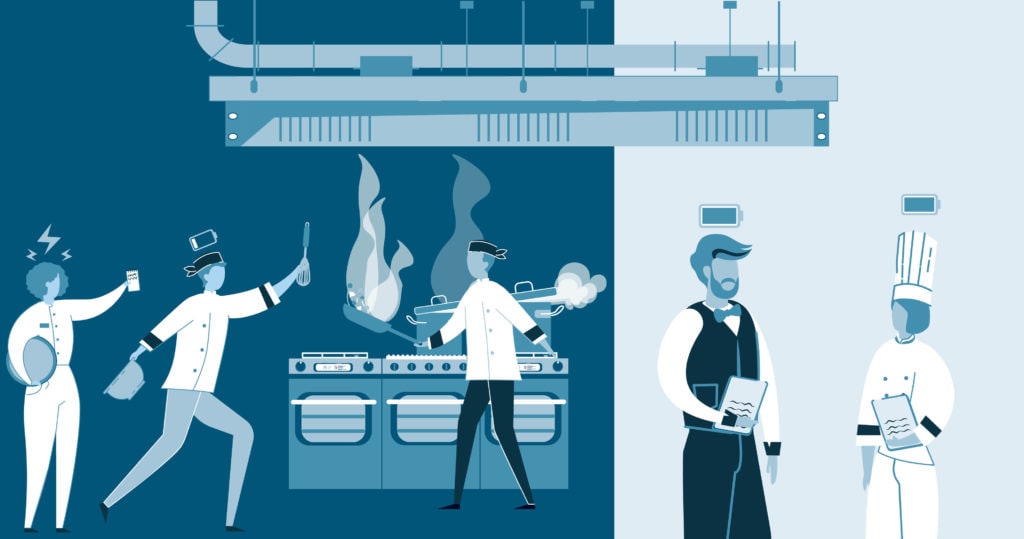
The push for sustainability in foodservice has gathered momentum in the last decade. Chefs and operators have worked hard to reduce food waste, single use plastics have become unacceptable and there is an ongoing focus on reducing emissions. The recent report into the climate crisis, published by the Intergovernmental Panel on Climate Change, has vindicated those working for change – and much more is required from a sector that has a considerable carbon footprint.
But can a restaurant call itself truly sustainable if it doesn’t have the same laser focus on its people? There’s a growing sentiment among restaurateurs that sustainability in 2021 should extend far beyond climate credentials.
“I think people are still uninformed about sustainability. You sometimes hear them talking about it as reducing plastic use and food waste, which is great, but it’s much more than that,” says Davide Caranchini, chef owner of Materia restaurant by Lake Como, Italy. “To me it means not only thinking ‘green’ and acting in an ethical way with food. Almost everybody now knows about no waste, and I think it’s normal to act in that way. Now, when we talk about sustainability we need to talk about economic sustainability and how to preserve a circular gastronomy.”
It is a philosophy shared by fellow Italian chef Diego Rossi who owns the modern trattoria Trippa in Milan. “When we talk about sustainability we must talk about human sustainability,” he says. “In Trippa the team works eight hours a day; I understand that they have a life and this way they work better. If we spend 18 hours in the kitchen, we can’t think about what we are doing.”
Making people happy
Rossi’s eight-hour day would have been unthinkable just 10 years ago, but recent events have brought the issue of people to the top of the agenda.
The Covid-19 pandemic has upended the foodservice sector the world over; restaurant closures in the thousands mean many lost their jobs – in the US alone it is estimated 2.5 million jobs were lost during the pandemic. Many employees used the time away from work to take stock and decided a career in hospitality was not what they wanted after all. Now the sector needs to respond.
 “The way we deal with people in hospitality is going through big changes after the pandemic – people have had time to understand that it’s not only about working 18 hours a day for less than the minimum wage, being mistreated,” says Caranchini (right). “In my own restaurant, I’ve always wanted to create a workplace that was disciplined but friendly and making people happy about working here.”
“The way we deal with people in hospitality is going through big changes after the pandemic – people have had time to understand that it’s not only about working 18 hours a day for less than the minimum wage, being mistreated,” says Caranchini (right). “In my own restaurant, I’ve always wanted to create a workplace that was disciplined but friendly and making people happy about working here.”
Recognizing the need to improve his team’s work/life balance, he has added an extra day off and increased the number of people employed in order to decrease the amount of work for every person.
Of course, the staffing challenge is not a result of the pandemic; it existed long before Covid-19 changed the world. A career in hospitality was not desirable – long hours, low pay and little attention paid to the wellbeing of team members meant that few would last long even if they wanted to.
Highly publicized cases of sexual harassment and discrimination in the sector that have come to light in recent years may not have made it more appealing, but it has at least forced change.
The staffing crisis is not unique to any one country or region; from France to Australia, foodservice and hospitality operators are struggling to recruit. Danny Meyer, the New York City restaurateur behind dining landmarks including The Gramercy Tavern and the popular fast food chain Shake Shack, has predicted it will take many years to get staff back. He has described the ruthless cuts he made to counter revenue loss as the pandemic took hold – going from 2,300 staff members to 150 in March 2020 – as the worst time of his professional life. Although he has started to rebuild, he says finding talent now represents the biggest challenge in hospitality.
In the UK, the problems have been compounded by Brexit, which meant an estimated 92,000 hospitality workers left the country to go back to their home country, according to data collated by
The Caterer.
Kate Nicholls, the chief executive of trade association UK Hospitality, says that across the hospitality industry, there are currently about 188,000 open positions. It is affecting all levels of the industry, from fast casual chains to fine dining establishments – Le Gavroche, a renowned London restaurant and the holder of two Michelin stars, announced earlier this year that it would have to cease lunch service due to staff shortage.
Local and systemic change
Add to this an escalating climate crisis that puts pressure on the entire food production system. Many chefs and operators have long understood that working with local producers was imperative to the future of the global community.
 Azurmendi, the three Michelin starred restaurant near Bilbao in Spain was built with sustainability at its heart and chef Eneko Atxa (left) was awarded the prize for most sustainable restaurant by the World’s 50 Best Restaurants in 2018. For Atxa, a vital element of responsible behavior is his relationships with local farmers.
Azurmendi, the three Michelin starred restaurant near Bilbao in Spain was built with sustainability at its heart and chef Eneko Atxa (left) was awarded the prize for most sustainable restaurant by the World’s 50 Best Restaurants in 2018. For Atxa, a vital element of responsible behavior is his relationships with local farmers.
“Without these producers we simply couldn’t do what we do. These are people who bring the best of what they do to our restaurant, so it is easy for us to cook. They are the reason we can do what we do,” he says. “Working closely with people near us doesn’t make us radical. It is very normal for us to work with people who are close and who have become friends.”
His relationships with suppliers meant he was able to direct other restaurants to farms when he couldn’t buy their produce during the lockdown. “When we were closed, the team from Restaurant Frantzen in Stockholm got in touch to find out where they could source the peas we use, so I connected them with my supplier and it meant he could keep working,” he says. “We [restaurants] had a bad time in the pandemic, but these producers had an even worse time.”
At Materia, Caranchini’s decision to only work with small producers – cheesemakers, breeders, foragers, fishermen – works for both sides. He gets the best quality products, and the suppliers receive consistent support, especially needed after a tough year.
“If we – chefs and restaurateurs – don’t act in a sustainable way with our suppliers, paying them the right amount for the job and within the given deadlines, they wouldn’t be able to keep working in a sustainable and ethical way,” explains Caranchini. “If I buy fish from a local fisherman, who is fishing only at the correct time, respecting the season and the reproductive cycle of the fish, and I don’t pay him or I pay him too late, in order to survive he might start to fish in the wrong way, forgetting about sustainability.”
Much of the industry understands that major systemic change is needed and now is as good a time as ever to implement this. Acknowledging that menu prices have previously not reflected the true cost of the dish on the menu represents a first step for many – increasing prices to cover other costs such as decent staff wages is starting to be seen as acceptable, expected even.
Earlier this year Amanda Cohen, the chef owner of New York City restaurant Dirt Candy, addressed increasing prices by $30 to $85 for a five-course menu on re-opening after the pandemic in an Instagram post. “2020 forced the restaurant business to get real about how it treats its workers, and I’ve had to admit that in order to serve my customers, I failed my staff. To run the kind of restaurant I need to run, I have to serve both,” she said.
“$30 more, that’s all it takes. But I need your support. If you don’t come, this doesn’t work. Everyone spent 2020 calling restaurant workers and delivery drivers heroes. We called them ‘essential’. We said we had their backs. Now’s the time to put those words into action.”
Paying staff a salary they can live on has been at the core of Tracy Chang’s philosophy at her restaurant Pagu in Boston, since launch and it was especially important during the pandemic. “We make sure we pay our employees enough that they don’t need a second job, that they don’t need to take public transit, they don’t need to go to the grocery store. We provide all of that and I think that’s the bare minimum you can do as a business owner.”
Movement in a different direction
Adding the human dimension to the sustainability equation may have been bubbling under the surface until now, but there is belief that for the foodservice sector to thrive, it needs to be part of the conversation. Earlier this year, at the Spanish gastronomy congress Madrid Fusión chefs appeared to share their take on circular gastronomy, the conference theme. It was striking that all took it as given that foodservice and hospitality today understand the importance of environmentally responsible practice; the next level is the imperative to support people.
In other words, without consideration for the human side, there can be no such thing as sustainable behavior.  “You have to be consistent. You can’t say you are championing sustainability if you have people in tears or mentally exhausted and deprived of any personal time. So, before you pick up the phone and order any fish, you need to know everybody is happy,” says chef Joshua Niland (right), the owner of Saint Peter and Fish Butchery in Sydney, Australia. “We all have our heads down and our eye on something else, but I hope there is attention being shown to the people because too many are leaving the industry or crying inside.”
“You have to be consistent. You can’t say you are championing sustainability if you have people in tears or mentally exhausted and deprived of any personal time. So, before you pick up the phone and order any fish, you need to know everybody is happy,” says chef Joshua Niland (right), the owner of Saint Peter and Fish Butchery in Sydney, Australia. “We all have our heads down and our eye on something else, but I hope there is attention being shown to the people because too many are leaving the industry or crying inside.”
As the restaurant community continues to emerge from the pandemic and reflecting on the way forward, Caranchini measures his restaurant’s successful recovery by the state of his team.
“We haven’t fired a single staff member and it’s paid off when we’re open, with the full team happy to be back instead of searching for new staff members, which is now a very tough task,” he says. “These should not be things to be remembered for, but it’s a start. Many people in the industry are now acting like this and I think that this could be the real change for the hospitality.”
Tina Nielsen




